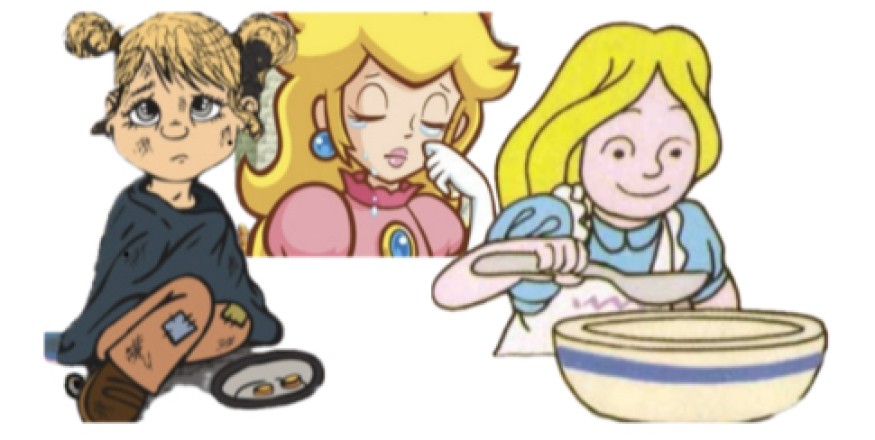Once upon a time there lived a girl named Hannah Meyer. She was born in Berlin on October 1, 1897. Her family moved to America when she was three. Her immigrant father was poor and had few skills. He got a factory job in New York City making 10 cents an hour, working 12 hours a day, six days a week.
The family was crammed into one room on Manhattan’s Lower East Side. Their landlord was greedy and dishonest. He subdivided an apartment meant for one family into units for three. They did not have electricity, running water, plumbing, or even a window.
Angry about the American Dream being a lie, her father, Julius, often came back to the room after work drunk. He would thump on his wife, eat his porridge, then pass out, ready for the next half day of sweltering factory work that lay ahead.
At fourteen, Hannah got her own job. One at the Triangle ShirtWaist company, cutting cotton fabric for women’s blouses. She worked nine hours a day on weekdays, plus seven hours on Saturdays, earning $7.64 for 52 hours of work.
One day, on March 25, 1911, she was at her table with her scissors. Someone sneaking a cigarette started a scrap bin on fire. The flames soon spread until they consumed the eight, ninth, and tenth floors. Because the doors to the stairwells and exits were locked to prevent workers from taking unauthorized breaks and to reduce theft, many of the workers could not escape from the burning building. The only fire escape, a flimsy, poorly-anchored device, melted and was useless. The inferno caused the deaths of 123 mostly young immigrant girls and 23 men.
Hannah clung to a tenth floor window ledge until she began getting licked by the pursuing flames. With her clothes and hair ablaze, she let go and fell like a human torch to the street below. Her mangled body was a smoldering pulp. It was scooped up and dumped into a wooden coffin on the spot.
**********
For a second time, there was born a girl named Hannah Meyer. On September 25, 1921, she was delivered by midwives in the family’s New York City Fifth Avenue brownstone mansion. Her grandfather, Herman, got rich in the garment business by supplying Civil War uniforms to the Yankees. Father, Conrad, continued the family’s good fortune by dressing doughboys for World War I.
Hannah was an only child. A pampered only child. Even while most Americans struggled and starved through the Great Depression, she did not. The Meyer money was safe, and although there was talk of trouble brewing again in Germany, her life should have been bright.
It was not. Her parents were strict prohibitionists who refined their only child with strict education, etiquette, and cello lessons. Twelve hours a day, six days a week, Hannah was groomed to be a lady. Anything less was for the vermin skittering about in their Lower East Side ratholes. Anything less was an affront to Martin Luther’s malicious God.
At fourteen, she was sent off to a Connecticut boarding school. At eighteen, both parents were killed when their TWA airliner lost a propeller soon after takeoff, and crashed into the East River near the Queensboro Bridge. Hannah was the sole beneficiary of 100 million dollars, with millions more coming in after the Day of Infamy.
In 1946, Hannah married her first husband. He was a World War II bomber pilot, now the self-proclaimed, ‘Cock of the Castle’. He spent her money like water, appropriate because he drank like a fish. He was trying to drown the ghosts of all the innocent men, women, and children he had blown to porridge from above, but could not. He took his anger out by thumping on his wife until she divorced him after only nineteen months of welted bliss.
Her second husband, a grifting real-estate speculator with ties to the Mob, got half of Hannah’s inheritance in her next divorce and built buildings with it. A third, a renowned Broadway producer, got the rest.
Hannah became a reclusive alcoholic and died of cirrhosis of the liver sometime around mid-August, 1986. The exact date of her death was inconclusive because her decomposed body wasn’t discovered until a few weeks later. It was scooped up off her mattress and squished into a body bag.
**********
For a third time, there was born a girl named Hannah Meyer. She came into the world on March 9, 1991, in the Lenox Hill maternity ward. Her mother wore a hospital gown made in dad’s Bronx garment factory. It also produces pinstripe uniforms for the Yankees. The Meyers were not poor. They were not rich because they gave most of their money to charity. They were comfortable with a nice house in Yonkers. Her doting, encouraging parents were social drinkers. Dad, Karl, was the life of any social gathering. Hannah had a very happy, very normal, childhood.
After graduating from Queens College in fashion design in 2012, she created her own line of women’s blouses. Her label is called 764, named for the number of her spacious Sutton Place condo overlooking the East River and the Queensboro Bridge. 764 is also the autoignition temperature, in Fahrenheit, of cotton fabric.
Her factory takes up three floors of a Manhattan high-rise. It employs union workers. They get fair pay, weekends and holidays off, health insurance, and a 401K. They get ten personal and sick days off. They earn time-and-a-half after forty hours. The building meets NYFD fire codes. The Occupational Safety and Health Administration ensures there are safe and healthful working conditions for every worker. It sets and enforces standards and provides training, outreach, education, and assistance for each of them.
Hannah has a boxer named Julius. She’s big on philanthropy. She runs a non-profit community restaurant in the Lower East Side that serves in-need customers. It does not serve steak or lobster, but it does not slop out porridge, either. Sometimes she volunteers to help wash dishes. She has many friends and is happy. She is vivacious and bright. She loves and is loved.
Hannah Meyer’s third life is just right.
ns 15.158.61.50da2





















